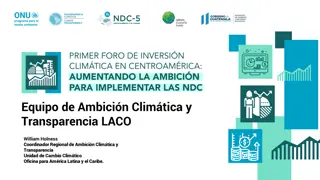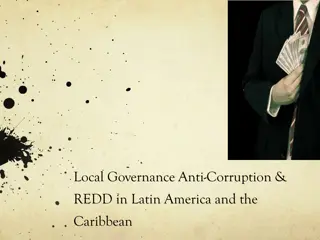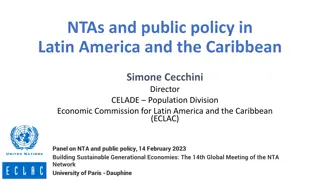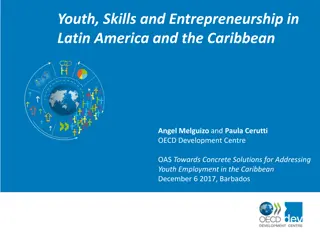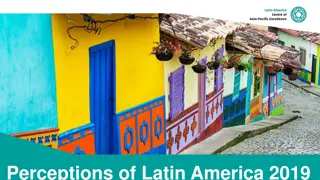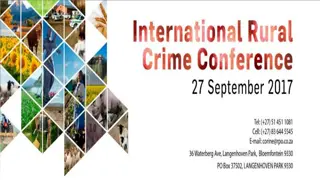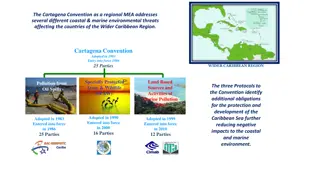Addressing Rising Crime Levels in Latin America and the Caribbean Region
Security and stability in the Latin American and Caribbean region are facing serious threats due to increasing crime levels, particularly in narcotics trafficking. The Treaty of San José, aimed at combating illicit maritime and air trafficking in narcotics, plays a crucial role in enhancing regional security cooperation. Challenges include the need for expanding territorial connectivity and addressing evolving forms of transnational organized crime beyond drug trafficking.
Uploaded on Sep 28, 2024 | 0 Views
Download Presentation

Please find below an Image/Link to download the presentation.
The content on the website is provided AS IS for your information and personal use only. It may not be sold, licensed, or shared on other websites without obtaining consent from the author. Download presentation by click this link. If you encounter any issues during the download, it is possible that the publisher has removed the file from their server.
E N D
Presentation Transcript
THE PROBLEM Security and stability in the Latin American and Caribbean region are under serious threat of rising crime levels. Increased trafficking of narcotics through the region. Rising associated crime levels such as arms smuggling, money laundering and gang formation. Narcotics trafficking most significant driver undermining stability, eroding good governance and democratic structures, causing excessive violence, feeding corruption, gang formation and other forms of criminalization, largely exceeding local law enforcement capacity. Raised urgency of finding common strategies and instruments to combat crime and limit the impact on our societies. Largest quantities of drugs, partly or entirely, smuggled via maritime routes. Generally agreed: urgent need for a legal instrument that can serve as a basis for more effective regional security cooperation in the maritime domain to enhance the fight against transnational organized crime. Such an instrument already exists and is more relevant and applicable than ever:
THE TREATY OF SAN JOS Or the Agreement Concerning Co-operation in Suppressing Illicit Maritime and Air Trafficking in Narcotic Drugs and Psychotropic Substances in the Caribbean Area , as it is officially called, a.k.a. the Caribbean Regional Agreement (CRA) Came into force in 2008. Currently, 9 countries signed and ratified the Treaty: Belize, Nicaragua, Dominican Republic, Costa Rica, Honduras, Guatemala, France, US, Netherlands 4 Countries signed but not yet ratified: Jamaica, Panama, Haiti and UK. Not signed: the (remaining) CARICOM nations, Mexico, Colombia, Cuba and Venezuela.
WHAT IS IT FOR? The Treaty s objective states that Parties shall co-operate to the fullest extent possible in combatting illicit maritime and air traffic in and over the waters of the Caribbean area, with a view to ensuring that suspect vessels and suspect aircraft are identified, and - where evidence of involvement in illicit traffic is found- detained . Most frequently encountered method of trafficking drugs in the Caribbean is by go-fast vessel. The close proximity of some countries in the region allows go-fasts to transport drugs from one jurisdiction to another in sometimes a matter of minutes. Such interdiction operations often require multilateral and pre-arranged information sharing and operational protocols in order for the nations concerned to cooperate more effectively than the drug smugglers. The Treaty provides a unified approach for doing exactly that, intending to inhibit drug traffickers and deny them their present flexibility in choosing routes and exploiting geographical vulnerabilities. It aims to prevent drug traffickers from using territorial seas as havens to escape maritime law enforcement vessels and aircrafts in and over international waters.
TREATY EXPANSION AND OPERATIONALIZATION: CHALLENGES Lack of territorial connectivity: states that joined Treaty so far are geographically too far removed from each other. More states joining will automatically connect more national jurisdictions and enhance application of Treaty. Crime in the region has evolved; human trafficking, arms smuggling, piracy, etc.; currently fall outside scope of Treaty. However, illicit drug production and trafficking, particularly cocaine, accounts for vast majority of TOC activity in/from the region. Other crimes (drugs, money laundering) are either related to illegal drug industry or make use of infrastructure set up by that same industry. Geographical coverage limited to Caribbean area.
The Treaty of San Jos Signed and ratified by only 9 states Main obstacle to effectiveness: Lack of territorial connectivity Maritime borders The Bahama s Turks & Caicos Islands Dominican Rep. Cayman Isl British Virgin Isl. Puerto Rico Anguilla St. Kitts & Nevis Antigua & Barbuda Jamaica St. Maarten Montserrat Guadeloupe Dominica Martinique St. Lucia Barbados Aruba Cura ao 9 signed & ratified 1. Costa Rica 2. Guatemala 3. Belize 4. Nicaragua 5. Dominican Republic 6. USA 7. France 8. Netherlands 9. Honduras Grenada Trinidad & Tobago 4 signed but not yet ratified 1. Panama 2. Jamaica 3. Haiti 4. United Kingdom Suriname
THE WAY FORWARD In 2021/2022 work closely with our partners (US, Costa Rica, CARICOM) to start process to actively promote the Treaty, identify obstructions to joining and offer solutions. Two tracks: 1. diplomatic engagement, 2. technical advice. Netherlands will finance UNODC project that offers technical support to this process. UNODC will support by engaging potential Treaty members individually and in regional technical meetings to: 1. identify key interlocutors, 2. identify (mis)perceptions, legal obstructions and political barriers to joining the Treaty and 3. inform and advice on designing solutions (f.e. possible modifications, amendments). Should culminate in 2nd high-level Meeting of the State Parties in 2021 or early 2022, where hopefully new state parties can be welcomed or interested nations can express intentions to join.



